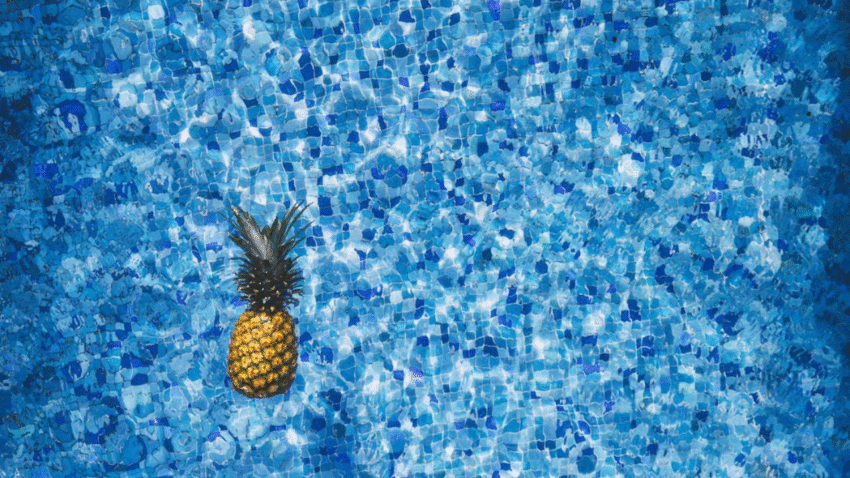Introduction
Have you noticed brown or reddish stains bleeding through your pool’s surface? If so, you may be dealing with rebar rust — a hidden but serious problem that can damage your pool over time. In this guide, you’ll learn how to repair rebar rust spots in a pool with a complete, step-by-step approach. From identifying the issue to removing the rust and sealing the area, we’ve got you covered so you can protect your pool’s structure and appearance.
Why Rebar Rust Matters for Your Pool
Rebar is the steel reinforcement embedded in your pool’s concrete shell. When moisture reaches the rebar, it can begin to corrode, causing rust that pushes outward and stains the pool surface. This isn’t just a cosmetic issue — it can lead to:
- Structural weakening of the pool shell
- Cracks and surface damage
- Reoccurring stains even after cleaning
- Higher repair costs if ignored
Addressing rebar rust early helps maintain your pool’s integrity and keeps it looking clean and professional.
Step-by-Step Guide to Repairing Rebar Rust Spots
Step 1: Identify the Rust Spot
Rust stains from rebar typically:
- Appear as brown, orange, or reddish blotches
- Bleed through plaster, marcite, or pebble surfaces
- Do not scrub away easily
- Return after temporary stain removal
💡 Tip: If a rust stain reappears after being cleaned, it’s a strong sign the source is deep corrosion from embedded rebar.
Step 2: Drain the Pool (If Required)
For small, shallow stains, you may be able to work underwater using specialized tools. But for best results — especially for deeper or multiple rust spots — partially or fully drain the pool.
⚠️ Caution: Always consult a professional before draining an inground pool. Improper draining can cause structural damage due to hydrostatic pressure.
Step 3: Chip Away the Affected Surface
Using a hammer and chisel (or a rotary hammer with a chisel bit):
- Chip away the plaster or pebble finish around the rust stain
- Create a small crater exposing the steel rebar underneath
- Remove enough material to access clean, unaffected concrete around the rebar (typically 2–4 inches in all directions)
💡 Pro Tip: Mark the center of the rust stain before chipping so you don’t lose track of the source during removal.
Step 4: Cut and Remove the Corroded Rebar
Using a reciprocating saw or grinder with a cutoff wheel:
- Cut out the rusted section of rebar completely
- Remove all corroded steel, even if it means cutting several inches on either side
- Clean the cavity to remove any dust or debris
⚠️ Caution: Wear safety goggles, gloves, and a dust mask when cutting metal and concrete.
Step 5: Treat the Exposed Rebar Ends
To prevent future rust:
- Use a wire brush to clean the cut ends of the remaining rebar
- Apply a rust-inhibiting primer or rebar epoxy coating to seal the exposed metal
- Let the product cure according to manufacturer instructions (usually 24 hours)
This step is critical to preventing rust from returning.
Step 6: Patch the Area with Hydraulic Cement or Pool Patch
Once the rebar is treated:
- Fill the cavity with hydraulic cement or a pool-grade repair mortar
- Apply in layers, pressing firmly to eliminate air pockets
- Smooth the surface using a trowel to match the surrounding texture
- Allow curing based on product guidelines (typically 24–72 hours)
💡 Tip: Use a bonding agent before applying the patch for better adhesion.
Step 7: Refinish the Surface
If your pool has a plaster or pebble finish, you’ll want to blend the repair area to match the surrounding surface. Depending on your skill level, you can:
- Apply a plaster patch kit (DIY)
- Hire a professional to blend the finish seamlessly
Once repaired, refill the pool and balance the water chemistry before resuming use.
Common Mistakes to Avoid
- Only Treating the Stain on the Surface
Scrubbing or applying acid to remove the rust stain without addressing the rebar will only result in it returning. Always go deep. - Skipping Rust Protection on the Rebar Ends
Failing to seal the exposed metal will cause the rust to return — often within months. - Not Removing All the Rusted Rebar
Leaving any corroded steel behind undermines the repair. Cut it back to clean, uncorroded sections. - Using General Concrete Instead of Pool Patch
Standard cement may not bond well or withstand water exposure. Use pool-specific repair products. - Rushing the Curing Process
Let the patch cure fully before refilling the pool. Premature exposure to water can weaken the repair.
Extra Tips & Pool Hacks
- Use a Pool Epoxy Paint after repair to add extra protection to the patched area.
- Inspect for other stains during repair — tackling all rust issues at once saves time later.
- Schedule seasonal checkups to catch early signs of rust before they expand.
Need help identifying surface issues? Check out our guide on [how to clean pool stains on the floor].
Conclusion
Rebar rust spots aren’t just ugly — they’re early warning signs of deeper problems in your pool structure. By identifying the stain, cutting out the corroded metal, sealing the rebar, and patching the surface properly, you can restore your pool’s beauty and integrity. Don’t ignore rust — fix it the right way and enjoy a cleaner, safer pool for years to come.
📌 Bookmark this guide for your next pool repair project and stop rust at the source!
